Journal of Agricultural Science and Food Research
Open Access
ISSN: 2593-9173
ISSN: 2593-9173
Research Article - (2019)Volume 10, Issue 3
Lack of knowledge with farmers regarding the use of optimum fertilizers rate is one of the key cause of diminishing productivity of our soil. The current study was conducted with an aim to evaluate comparison between inorganic phosphorous fertilizers and phosphorous enriched citrus waste compost in enhancing the nodulation and obtaining economical yield of mungbean. The field trail was operated in Rabi season 2018-2019 using RCB design with 8 treatments and 3 replications. Total 8 treatments were used such as T1 (Control), T2 (Citrus waste compost alone) T3 (DAP alone), T4 (rock phosphate alone), T5 (SSP alone), T6 (4% DAP enriched CW compost), T7 (4% RP enriched CW compost), T9 (4% SSP enriched CW compost) and each treatment was replicated three times. The outcomes of the field trail showed that all the phosphorous treatment has significantly affected the nodulation and grain yield of mungbean but treatments containing phosphorous enriched citrus waste compost was far better in results as compared to treatments containing alone mineral fertilizers. Treatment containing 4% DAP enriched citrus waste compost has significantly increased the grain yield, plant height and number of pods per plant up to 65%, 49% and 43% respectively significantly followed by treatments containing 4% SSP and 4% RP enriched citrus waste compost. However, in case of nodulation maximum values were obtained for treatment receiving alone RP increasing the number and mass of nodules up to 72% and 64%. It was concluded that pretreatment of DAP with citrus waste compost makes the soil favorable for long term phosphorous uptake resulting in better grain yield and yield attributes of mungbean. Though the DAP enriched citrus waste compost was best in our results, but other levels and their consequent effect on soil and crop yields should be assessed along with their environmental risks for wider and long term recommendations.
Citrus waste compost; Mungbean; Grain yield; DAP; SSP; Rock phosphate
Mungbean scientifically called Vigna radiate L is a leguminous crop and belongs to a family Fabaceae. Due to its high adaptation in environmental stresses i-e drought phase or poor fertility status of soil, mungbean are the first choice of farmers to cultivate it in different cropping patterns [1,2]. It has also the ability to fix atmospheric nitrogen in nodules by symbiotic association with specific strain of rhizobium bacteria such as genus Bradirhizobium [3]. Grains of mungbean is composed of 49.4% carbohydrates, 25% proteins and 2-4% fats, in addition to that they also contain 365 and 134 mg of phosphorous and calcium per hundred grams of grains respectively [4]. In Pakistan its annual production is 105.4000 tons giving a yield at average of 451 kg ha-1 and this yield on our fields is very low as compared to the level of its potential yield such as 2710 kg ha-1 [5]. The main reason for this low yield are may be due to worse fertility status of our soil, inadequate use of organic and inorganic fertilizers, insect and weed invasion etc. Local farmers got a wrong concept about munbgbean that being a leguminous group; it does not require fertilizers leading to a severe loss of yield. However, application of essential nutrients to mungbean fields from organic and inorganic sources plays a vital role in obtaining an economical yield [6].
Phosphorous is second most essential nutrient after nitrogen in growth and development of plants. Soil constitutes 95 - 99% phosphorous in organic form, the rest of it is inorganic form and available to plants. The most important function of phosphorous is that it is involved in early root and shoot development, stem elongation, cell division and plays a vital role in meristematic activity of plants. The most important drawback of phosphorous fertilization in its rapid fixation in clays leading to severe deficiency problem in soils as well as in plants. There are various factors which can enhance the phosphorous availability to plants such as composting, lower pH of soil and enhanced microbial activity in soil [7,8]. Mineralization of phosphorous from organic form to inorganic form in positively affected by process of decompositions by microbes. Certain organic acids are released in soil as a result of oxidation of carbohydrates due to microbial activity leading to prevent the phosphorous from fixation and increases its chelation due to which it can be available to plants for long time [9,10]. Fertilizers including phosphorous are beneficial to mungbean plants in respect to its grain yield and other agronomic parameters [11,12]. The Fertilizer use efficiency of inorganic phosphorous fertilizers applied alone is very low as compared to those inorganic phosphorous fertilizers that are integrated organic fertilizers [13]. The possible reason in increase in fertilizer use efficiency is may be due to increase in cation exchange capacity which prevents the loss of nutrients from leaching and fixation [14].
Based on the above, this study aims to evaluate the role of phosphorous enriched citrus waste compost as compared to inorganic phosphorous fertilizers in enhancing the nodulation, grain yield and other yield attributes of mungbean.
A field experiment was carried out in Rabi season 2018-2019 at Research Developmental Farm, University of Agriculture Peshawar to evaluate the response of Mung bean (Vigna radiata L.) to various sources of soil phosphorous following application of pre-treated citrus waste compost. Before the initiation of the experiment, four types of composts such as 4% DAP enriched citrus waste compost, 4% R.P. enriched citrus waste compost, 4% SSP enriched citrus waste compost and alone citrus waste compost was prepared each on plan area of 9 m2. The compost was applied to the required experimental plots on the basis of 90 kg P2O5 kg ha-1. The total number of treatments used was 8 and each treatment was replicated three times thus making 24 experimental units. The area of each experimental unit was 4 m x 3 m = 12 m2. Mung bean was sown using plant to plant distance of 12 cm and row to row distance of 30 cm. The experimental design used was randomized complete block (RCB). The sources of P fertilizers used were Di-ammonium phosphate (DAP), Rock-phosphate (R.P.) and single super phosphate (SSP) and was applied to the desired experimental units based on 90 kg P2O5 kg ha-1 whereas basal dose of nitrogen and potassium is applied to each experimental plot. Nodules samples were collected at flowering stage whereas other data of yield traits were collected at different growth phases of plant.
Before the initiation of the experiment the composite soil sample was collected at depth of 15 cm from the field and was analyzed for different tests such as soil texture, pH, EC, bulk density, organic matter content, N, P and K content. The data in the Table 1 revealed that the soil of the experimental site was silt loam in texture having slightly alkaline pH, non-saline in nature, bulk density was high, the content of organic matter and nitrogen concentration was low, available P and K was in medium range. Half dose urea was allotted at the time of sowing while another half dose was applied with second irrigation. And at the time of sowing potassium was applied to each of the experimental unit at recommended dosage.
| Properties | Units | Concentration |
|---|---|---|
| Silt | % | 64.5 |
| Sand | % | 31.3 |
| Clay | % | 3.9 |
| Texture Class | _ | Silt loam |
| pH | _ | 7.71 |
| EC | dS m-1 | 0.235 |
| Bulk Density | g cm-3 | 1.28 |
| Organic Matter | % | 0.79 |
| Total Nitrogen | % | 0.08 |
| P (AB-DTPA extractable) | mg kg-1 | 3.54 |
| K (AB-DTPA extractable) | mg kg-1 | 80.64 |
Table 1: Physical and chemical properties of the soil of the experimental site.
Plant height (cm)
Plant height of mungbean is measured with help of graduated scale by randomly choosing 5 plants from each experimental unit in maturity phase of plant and then takes the average of heights of these 5 plants
Number of pods per plant
Number of pods per plant of mung bean is measured by randomly choosing 5 plants from each experimental unit in maturity phase of plant. The total number of pods on grown on each plant is counted then takes its average. It will give us total number of pods per plant.
Grain yield (kg ha-1)
Grain yield is calculated by collecting pods from 5 central rows of each experimental unit. After sun drying their grains were shredded and weighted by using electrical balance Then grain yield was calculated by following formula
Grain yield (kg ha-1)= Grain yield rows-1/R-R space (m) × row size (m) × No. of rows × 10000 m2
Number and weight of dry nodules
The total number and weight of nodules was calculated at 50% flowering stage of plant. Three plants were uprooted randomly from each plot and were washed carefully. The nodules were then separated from roots and were counted. The weight of nodules was taken after sun drying with help of sensitive balance.
Statistical analysis
ANOVA procedures suitable for RCB design was used for data statistical analysis. Means value were compared using LSD test at p<0.05 when the F values were significant [15]. The data was then also analyzed by computer software program STATISTIX 10.1.
Number and weight of dry nodules (g)
Mean values of number and weight of nodules per plant reveals that all the treatments and has significantly affected the process of nodulation in mungbean whereas negligible effect was seen in treatment receiving alone citrus waste compost and has least affected the nodulation in mungbean after control. Treatment receiving alone R.P. has given maximum values for number and weight of nodules (57.46 and 0.84 g) statistically similar to treatment receiving 2% R.P. enriched C.W. compost based on 90 kg P2O5 ha-1 which has produced 54.09 and 0.83 g of nodules per plant. The minimum nodules mass and number (0.51 g and 33.23) was calculated for Control treatment receiving no P fertilizers. By comparing the DAP treatments with R.P treatments the main reason for the low number and weight of nodules is presence of nitrogen in DAP treatments is the existence of NH4+ and NO3- in soil which lowers the number and volume of nodules [16]. There is inverse relation between available nitrogen in soil and number of nodules produced by plant. The poorer the soil in available N, the higher will be the number and mass of nodules. The same phenomenon is reflected in Figures 1 and 2. The increase in number and weight of nodules in R.P. treatments is due to the fact that the phosphorous plays as significant role in initiation of nodules growth and development as well as increases the proficiency of symbiosis process between legume and rhizobium thus augmenting nitrogen fixation [17]. The above data lies in line with Ditta et al. who founded that number and mass of nodules of chickpea plant was increased by rock phosphate pretreated with FYM in various ratios before application to field [18].
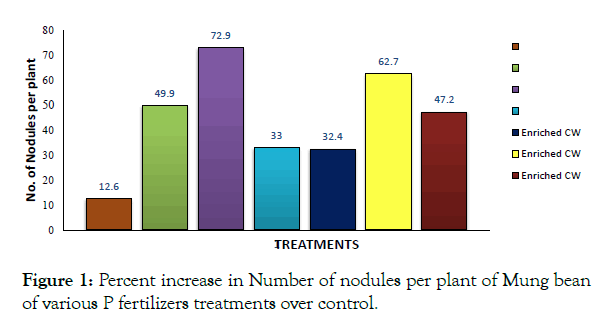
Figure 1: Percent increase in Number of nodules per plant of Mung bean of various P fertilizers treatments over control.
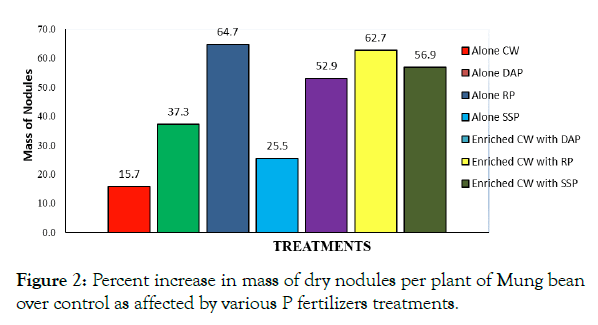
Figure 2: Percent increase in mass of dry nodules per plant of Mung bean over control as affected by various P fertilizers treatments.
Plant height, pods plant-1 and grain yield
Data in Table 2 shows the Mean values of Plant height, number of pods per plant and grain yield as affected by various organic, inorganic P fertilizers and phosphorous enriched citrus waste compost. Statistical analysis [p<0.05] of data showed all the treatments has significantly affected the plant height, number of pods and grain yield of mung bean. Treatment T6 receiving 4% DAP enriched C.W. compost has given maximum values of 68.00 cm, 24.4 and 1254.76 kg for plant height, pods number per plant and grain yield respectively, followed by treatment T8 and treatment T9 receiving 4% R.P. and SSP enriched C.W. compost based on 90 kg P2O5 ha-1. The minimum values of plat height, number of pods per plant and grain yield was given by Control treatment receiving no P fertilizers. By comparing the P enriched C.W. compost with alone inorganic P fertilizers treatments, P enriched C.W. compost treatments has positively enhanced the grain yield and other yield traits of Mung bean. The same phenomenon is reflected in Figure 3, 4 and 5 showing that 4% DAP enriched C.W. compost has increased the plant height, pods number and grain yield by 49%, 43% and 65% respectively. The possible reason for improvement of plant height, pods number per plants and grain yield is may be due to better availability of phosphorous due to its integration with citrus waste compost. Citrus waste compost having acidic reaction may have additional advantage over other organic residues as compost materials in alkaline calcareous soil [19]. Citrus waste compost has pH below 6, thus making conditions favorable for phosphorous uptake by plants. Mineralization of phosphorous from organic form to inorganic form in positively affected by process of decomposition by microbes. Certain organic acids are released in soil as a result of oxidation of carbohydrates due to microbial activity leading to prevent the phosphorous from fixation and increases its chelation due to which it can be available to plants for long time [9,10]. Fertilizers including phosphorous are beneficial to Mungbean plants in respect to its grain yield and other agronomic parameters [12]. While in case of inorganic P fertilizers, the phosphorous fixation might have taken place due to lack of organic fertilizers and lessen microbial activity leading it to poor plant height and poor grain yield. The above result lies in line with Jamal et al. and Ahmad et al. who founded that composting and integration of organic and inorganic fertilizers has a positive great impact on yield and yield traits of pulses [20,21] (Table 3 and Figure 6).
| Treatments | Number of nodules plant-1 | Mass of dry nodules plant-1 (g) |
|---|---|---|
| T1 = Control | 33.23 d | 0.51 d |
| T2 = CW compost alone | 37.42 cd | 0.59 cd |
| T3 = DAP alone | 49.83 abc | 0.70 abc |
| T4 = RP alone | 57.46 a | 0.84 a |
| T5 = SSP alone | 44.20 bcd | 0.64 bcd |
| T6 = 4% DAP enriched CW compost | 44.00 bcd | 0.78 ab |
| T8 = 4% RP enriched CW compost | 54.09 ab | 0.83 a |
| T9 = 4% SSP enriched CW compost | 48.92 abc | 0.80 ab |
| LSD < 0.05 | 3.68 | 0.017 |
CW = Citrus Waste; RP = Rock Phosphate; DAP = Di Ammonium Phosphate; SSP = Single Super Phosphate
Table 2: Effect of organic and inorganic phosphorous on number and weight of nodules.
| Treatments | Plant Height (cm) | Pods plant-1 | Grain yield (kg ha-1) |
|---|---|---|---|
| T1 = Control | 45.60 d | 17.2 d | 756.28 d |
| T2 = CW compost alone | 57.12 cd | 20.2 bc | 854.89 cd |
| T3 = DAP alone | 61.83 ab | 21.6 abc | 924.56 abc |
| T4 = RP alone | 59.76 a | 20.4 bc | 860.89 bcd |
| T5 = SSP alone | 55.20 bcd | 20.3 bc | 855.67 cd |
| T6 = 4% DAP enriched CW compost | 68.00 a | 24.4 a | 1254.76 a |
| T8 = 4% RP enriched CW compost | 64.09 ab | 22.5 ab | 1176.45 ab |
| T9 = 4% SSP enriched CW compost | 64.92 ab | 24.8 a | 1098.78 bc |
| LSD < 0.05 | 4.43 | 3.20 | 127.65 |
CW = Citrus Waste; RP = Rock Phosphate; DAP = Di Ammonium Phosphate; SSP = Single Super Phosphate
Table 3: Effect of organic and inorganic phosphorous on plant height, number of pods and grain yield of Mungbean.
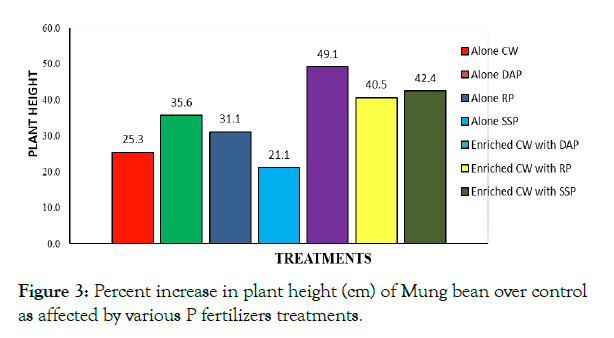
Figure 3: Percent increase in plant height (cm) of Mung bean over control as affected by various P fertilizers treatments.
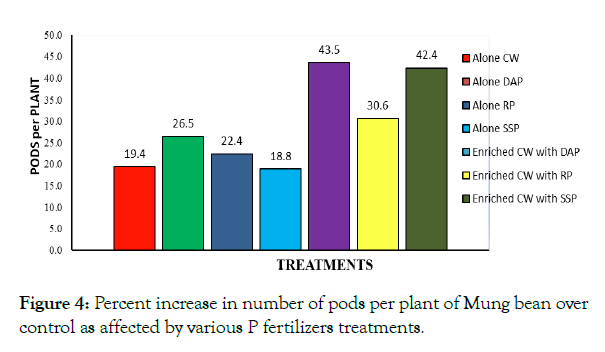
Figure 4: Percent increase in number of pods per plant of Mung bean over control as affected by various P fertilizers treatments.
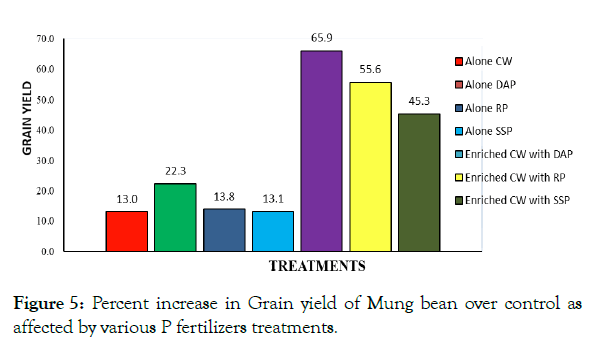
Figure 5: Percent increase in Grain yield of Mung bean over control as affected by various P fertilizers treatments.
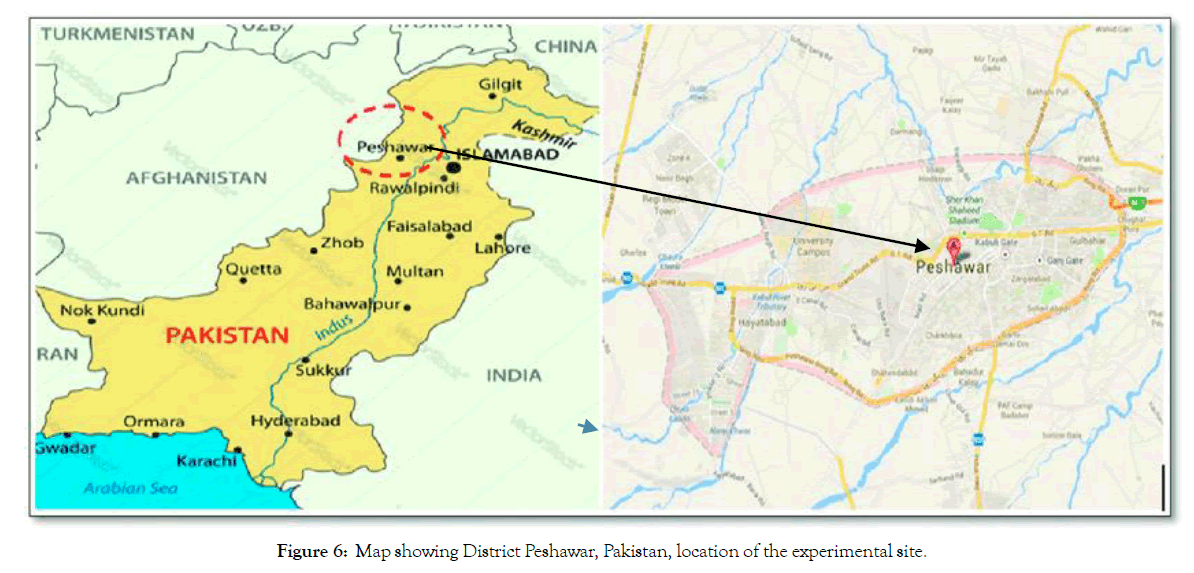
Figure 6: Map showing District Peshawar, Pakistan, location of the experimental site.
Treatments containing phosphorous enriched citrus waste compost were far better in results as compared to treatments containing alone mineral fertilizers. Treatment containing 4% DAP enriched citrus waste compost has significantly increased the grain yield, plant height and number of pods per plant up to 65%, 49% and 43% respectively and hence recommended for obtaining economical yield of mungbean. Though the Phosphorous enriched citrus waste compost was best in our results, but other levels and their consequent effect on soil and crop yields should be assessed along with their environmental risks for wider and long-term recommendations.
Citation: Khalil MK, Qureshi SUR, Khan MO, Ishaq F, Tariq M, Nawaz S, et al. (2019) Enhancing Effects of Phosphorous Enriched Citrus Waste Compost on Nodulation and Various Yield Attributes of Mung Bean in Peshawar District. J Agri Sci Food Res. doi: 10.35248/2593-9173.19.10.268
Received: 10-Oct-2019 Accepted: 22-Nov-2019 Published: 28-Nov-2019 , DOI: 10.35248/2593-9173.19.10.268
Copyright: © 2019 Khalil MK, et al. This is an open-access article distributed under the terms of the Creative Commons Attribution License, which permits unrestricted use, distribution, and reproduction in any medium, provided the original author and source are credited.